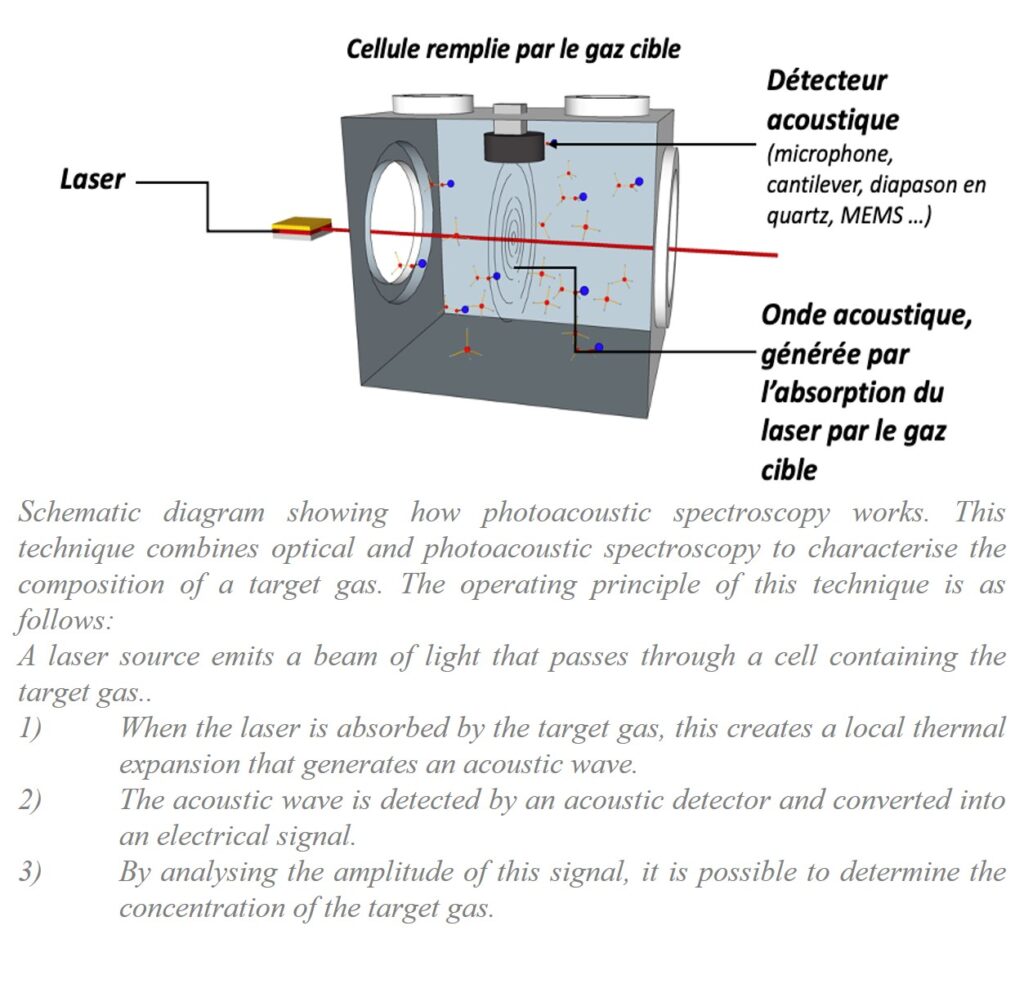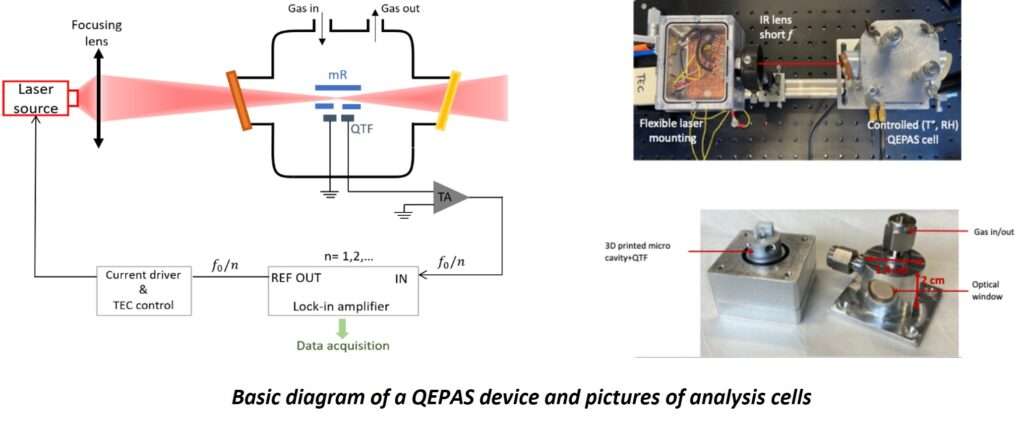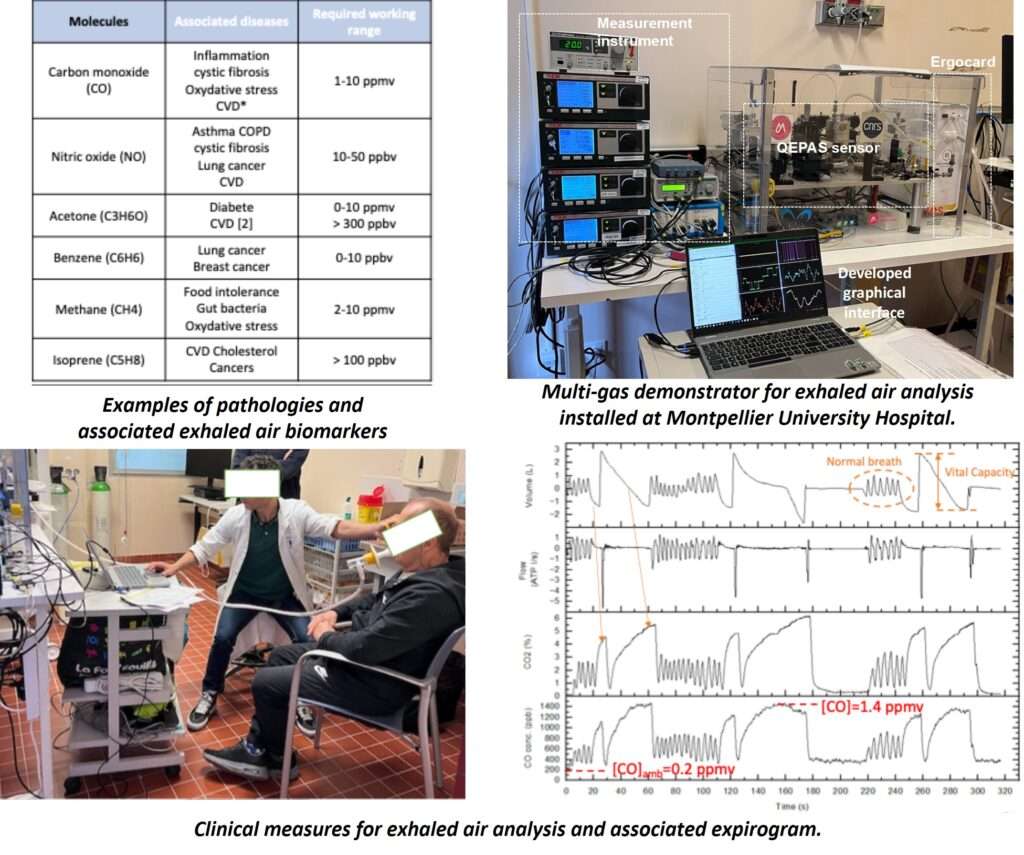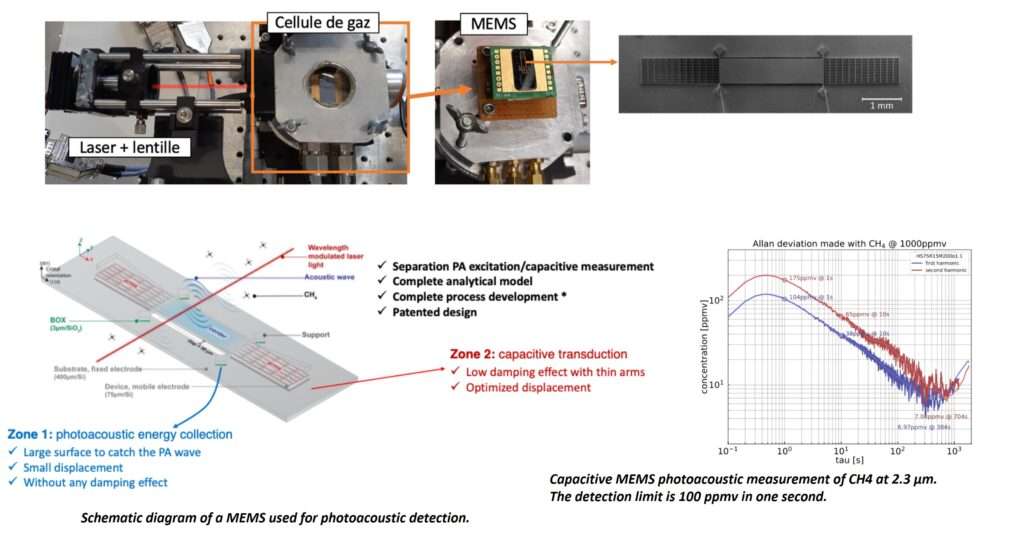Gas sensors
Staff: M. Bahriz, A. Vicet.
Post-doc: T. Seoudi (2023-2025).
PhD students: R. Rousseau (2017-2020), V. Trzpil (2018-2021), D. Ayache (2020-2023), J. Charensol (2021-2025), F. Pages (2024-2027), F. Abou Naoum (2024-2028).
Projects: ANR NOMAD, SENSIR (MUSE), MedicPas (Numev), EXPAIR (Nexus)
Other collaborations: CHU Montpellier.
Objective
We are working on devices dedicated to gas detection. The target species are, for example, methane, CO, CO2 (biomass regulation, estimation of thermal condensers, municipal landfills, lagoons, etc.) for industrial or environmental applications, but also ethylene for biological and agri-food applications, NO or formaldehyde for in/outdoor pollution applications. We are also working with Montpellier Hospital to study a diagnostic solution in exhaled air, based on the measurement of specific biomarkers.
The sensors must be compact, lightweight and versatile, enabling real-time in situ measurements. We are working on several approaches that exploit photoacoustic spectroscopy using tunable semiconductor lasers. These are single-frequency sources with distributed feedback emitting in the 2 to 19 µm range, based on several type of active regions such as InGaAsSb/Al(In)GaAsSb quantum wells, InAs/AlSb quantum cascade or even interband cascade lasers. These spectroscopic techniques are extremely selective and highly sensitive.
Photoacoustic Spectroscopy
There are three main families of gas sensors capable of real-time, in-situ measurement: electrochemical sensors, semiconductor-based sensors and optical detectors. The latter are the only ones capable of perfectly discriminating the spectral signature of one species from another. For reasons of compactness, semiconductor lasers are used as sources. The technique is called TDLS (tunable diode laser spectroscopy).
Photoacoustic spectroscopy is derived from TDLS. The principle of operation is shown in the figure below. Optical detection is replaced by acoustic detection. When the laser light is absorbed by the target gas, it causes local heating. This creates a pressure change that is measured by an acoustic detector, such as a microphone. The detection is independent of the optical wavelength and the length of the optical path, which makes it possible to work with very small volumes of gas. This allows measurements to be made in real time, making it particularly useful for environmental and medical applications where rapid gas detection can be critical. For these reasons, photoacoustic spectroscopy is a technique with great potential for multi-gas detection, while remaining extremely sensitive, selective, compact and reactive. It does not require an optical detector and can be used to detect any gaseous species simply by replacing the laser used with a laser whose emission wavelength coincides with the absorption line of the gas to be detected.

Recent results
1. Quartz enhanced photoacoustic spectroscopy (QEPAS)
The QEPAS detection uses a commercial quartz resonator with a high quality factor as a transducer for the detection of the acoustic wave generated after IR absorption. The off-beam configuration allows rapid alignment and decoupling of the acoustic excitation and IR absorption.
This technique has been used with different sources in various configurations and has shown very good measurement capabilities. The measurement of broad-spectrum species such as acetone, isoprene and benzene was studied, using both laboratory-built and commercial sources.

2. Breath analysis for medical diagnosis
Exhaled air contains numerous trace molecules, biomarkers of pathologies. To identify a pathology, it is necessary to measure several species, and to acquire data in real time to identify the respiratory compartments, in particular the alveolar compartment, the site of gas exchanges between the blood and the lungs.
A QEPAS multi-gas device was developed in collaboration with the hospital and the PhyMedExp laboratory in Montpellier, then installed at the hospital to conduct a clinical study on the diagnosis of heart failure.

3. MEMS photoacoustic spectroscopy
Another approach to measuring the signal is to use a MEMS (micro-electromechanical systems) specially developed for photoacoustics. The measurement is capacitive on a resonator that decouples the acoustic excitation from the electrical measurement to reduce the effects of viscous damping.
Prospects for improvement include the study of surface variation designs coupled to an acoustic cavity.
